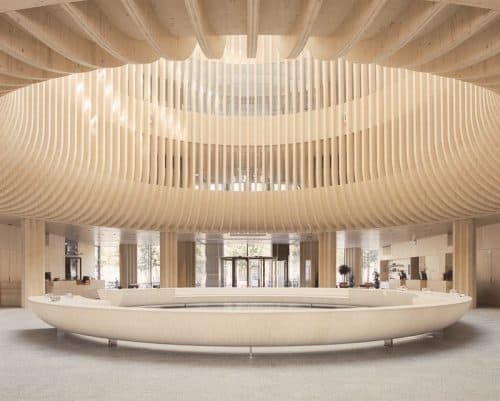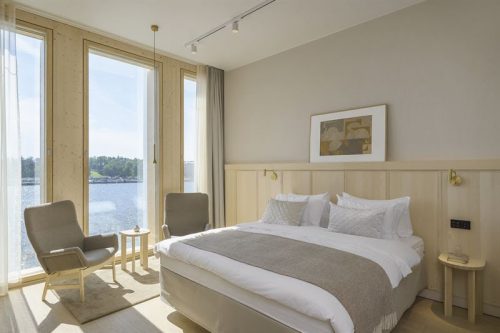Katajanokan Laituri, the new wooden landmark building in Helsinki, houses a hotel aiming to be the most sustainable one in Finland.

Increasing wood construction is one way to build a more sustainable future and achieve Helsinki’s target of becoming carbon-neutral by 2030. Designed by Anttinen Oiva Architects, Katajanokan Laituri is an impressive new solid wood building on Helsinki’s shoreline that complements the city’s signature skyline right next to Market Square.
The building houses the head office of the Finnish forest industry company Stora Enso and the new design hotel Solo Sokos Hotel Pier 4, which aims to be the most sustainable hotel in Finland. With the upcoming Museum of Architecture and Design, the area is developing into an exciting new hub of art and design beside the sea.
Developing the city’s building stock plays a key role in achieving the sustainability goals. It is important for Helsinki to create a lively urban environment and to make the city’s 131-kilometre shoreline even more accessible to locals and visitors. “The aim of transforming the Katajanokka shoreline area is to create a lively urban space.
With this project, we will be able to open the shoreline to the people of Helsinki. A building made of wood, that is durable and has as low a carbon footprint as possible meets the city’s goals,” says Deputy Mayor Anni Sinnemäki.
Helsinki’s new Architecture and Design Museum will further increase the appeal of the area. The first phase of the design competition closed on 29 August 2024.
A new architectural landmark in Helsinki’s historical centre

Katajanokan Laituri is a modern Finnish wooden building whose timeless architecture is the work of the award-winning Anttinen Oiva Architects. The building is owned by Varma Mutual Pension Insurance Company and it houses the head office of the forest industry company Stora Enso, which also supplied the solid wood load-bearing elements of the building. The four-storey building is made from Finnish and Swedish timber and combines pioneering architectural methods with traditional and sustainable materials.
Wooden structures have been left visible in the interior as much as possible, and nature is also strongly present: in addition to solar panels, the building features a multi-species green roof, and a small birch tree forest is growing in the hotel’s atrium. The building functions as a carbon storage and is made to last for the next 100 years. Flood protection also makes the building future-proof, as it can withstand a water level rise of more than 3 metres.
Stora Enso’s former head office designed by legendary Finnish architect Alvar Aalto is located right next to the new building. The district is otherwise known for its Art Nouveau architecture from the beginning of the 20th century. A short walk away is Helsinki’s historic centre designed by Carl Ludvig Engel.
Most environmentally sustainable hotel

The new Solo Sokos Hotel Pier 4 aims to be the most sustainable hotel in terms of everything from the building itself to the hotel’s functions and services. A LEED Platinum environmental certificate will be applied for the whole building aiming for carbon neutrality and using energy solely from renewable sources. The hotel will also apply for Green Key and Sustainable Travel Finland certificates.
The hotel has 164 rooms, 43 of which afford unobstructed views of the sea. The hotel also has conference facilities, a seaside café, and a rooftop terrace with views of Market Square and South Harbour. Sauli Kemppainen, a Finnish chef with a passion for simplicity and pure taste, leads the hotel restaurant Harbour. He has previously been awarded a Michelin star. Each dish at Harbore consists of only two main ingredients prepared in various ways, such as reindeer and onion, with Finnish and Nordic produce accounting for up to 85 per cent of all ingredients used.
Read more: Latest



